My Camino Day 8/5 2018
My Camino Day 8/5 2018 added some wonderful experience to my Camino de Santiago del Norte journey.
Memory plays tricks. It was not until I began working on this post that I learned that I had first heard, or read, the advice that it is “El Camino, not El Destino. The walk is the trip,” all the way back in 2016. Somehow, I thought reading that simply confirmed what I had learned in my own journey; now I know that August 5th, 2018 simply showed me how true that advice is. While the middle of My Camino Day 8/4 2018 carried that message beautifully, the middle of the day on August 5th my memory says my understanding of it began.
The Beginning
Memory plays tricks. It says that I awoke to a busy, bustling bunkroom filled with peregrinos madly stuffing their gear into backpacks, pulling the sanitary covers off their bunks, and crowding through the door to leave Albergue de peregrinos Santa Ana in a competition to be the first to leave; that between the time I awoke and the time I sat up in my bunk, they all had left and I was alone with volunteers beginning the task of tidying up; that my slowness in my morning ablutions put me in the way of those volunteers as the last of the pilgrims to leave the building.
I would learn over the coming years that this is an El Destino focus that is common, but I have no wish to share.
The Middle
 My plan was to visit a cafeteria or restaurant in the charming town of Pasai Donibane for my morning coffee so I walked down the stairs from the albergue to the town and, to my distress, did not find one that was open. I was unprepared for such a situation, but optimistic that there would be somewhere to get the several cups that make my morning, and me, bright, so I went to the ferry for the quick trip across the estuary to the Pasaia de San Pedro side without making a real search on the Pasaia de San Juan side. In retrospect, that was very likely a mistake.
My plan was to visit a cafeteria or restaurant in the charming town of Pasai Donibane for my morning coffee so I walked down the stairs from the albergue to the town and, to my distress, did not find one that was open. I was unprepared for such a situation, but optimistic that there would be somewhere to get the several cups that make my morning, and me, bright, so I went to the ferry for the quick trip across the estuary to the Pasaia de San Pedro side without making a real search on the Pasaia de San Juan side. In retrospect, that was very likely a mistake.
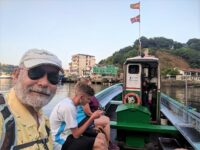 The ferry is a small, green boat that carries folks from one side of the estuary to the other for €0.80, or a bit less than a dollar, in only a few minutes. The ferry ride itself is a short, pleasant one on a warm summer morning. That charm may well be reduced in the winter, which features (I’m told) cold, rainy, overcast weather.
The ferry is a small, green boat that carries folks from one side of the estuary to the other for €0.80, or a bit less than a dollar, in only a few minutes. The ferry ride itself is a short, pleasant one on a warm summer morning. That charm may well be reduced in the winter, which features (I’m told) cold, rainy, overcast weather.
The view of the albergue on the hill to the east, with the Sun rising over the mountain behind it, was beautiful.
My arrival on the western shore was immediately disappointing as there were no places to buy coffee, and breakfast if things were to be perfect, in sight. A disappointment. And a disappointment that quickly took on an aura of finality as the yellow arrows directed me along the western edge of the estuary. It was a flat and easy walk on a paved sidewalk and next to a low wall.
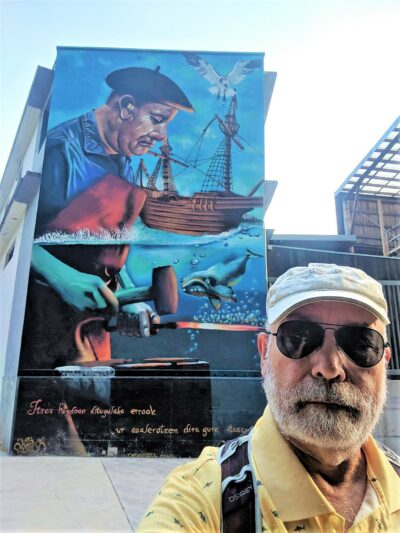 It was an interesting walk as well. I passed a building whose side had been painted with an impressive artwork showing a blacksmith in front of a whaling ship with the whale swimming below. It was an interesting artifact as there had been what appeared to be a whaleboat race in the estuary the day before. Now there appeared to be a pattern. Eventually, I would learn that whaling had been a very important industry along Spain’s northern coast in centuries past.
It was an interesting walk as well. I passed a building whose side had been painted with an impressive artwork showing a blacksmith in front of a whaling ship with the whale swimming below. It was an interesting artifact as there had been what appeared to be a whaleboat race in the estuary the day before. Now there appeared to be a pattern. Eventually, I would learn that whaling had been a very important industry along Spain’s northern coast in centuries past.
 Then I passed the ship I had seen from the mountainside on August 4th and learned it was named the Jaizkibel, apparently in honor of the mountain ridge that had been the middle part of my day. She was in drydock.
Then I passed the ship I had seen from the mountainside on August 4th and learned it was named the Jaizkibel, apparently in honor of the mountain ridge that had been the middle part of my day. She was in drydock.
The easy, level walk ended when I arrived at a set of stairs that began to climb the mountain and a view of the estuary’s entrance to the sea. It was a gorgeous view with the walls intended to break the surf before it entered the estuary in the foreground and a headland overlooking the Bay of Biscay in the distance.
 And so, a climb. The stone stairs were in fine condition and not too steep. Until they weren’t. They became steeper and their condition deteriorated until they were in poor poor condition. Those stairs, in turn, became rough stairs and the rough stairs became a deteriorated stairway that featured areas so deteriorated that peregrinos had created new paths around the most difficult spots.
And so, a climb. The stone stairs were in fine condition and not too steep. Until they weren’t. They became steeper and their condition deteriorated until they were in poor poor condition. Those stairs, in turn, became rough stairs and the rough stairs became a deteriorated stairway that featured areas so deteriorated that peregrinos had created new paths around the most difficult spots.
 Finally, I came to a place where erosion had so damaged the stairway that it had ceased to exist as organized stones and had become nothing more than a dirt track with the occasional solid, level stone footing.
Finally, I came to a place where erosion had so damaged the stairway that it had ceased to exist as organized stones and had become nothing more than a dirt track with the occasional solid, level stone footing.
And I had questioned that farm lane as I began my first climb on August 4th!
 Hiking el Camino de Santiago del Norte is a visual delight that was already making me wish for improved photographic skills, and perhaps a more capable camera than my Android smartphone. It included scenes with a human element, such as the young woman, apparently waiting for someone in a small parking are next to a road, who was reading a book. It included spectacular views, such as the estuary’s opening to the sea from the headland that had seemed so far away only an hour or so earlier.
Hiking el Camino de Santiago del Norte is a visual delight that was already making me wish for improved photographic skills, and perhaps a more capable camera than my Android smartphone. It included scenes with a human element, such as the young woman, apparently waiting for someone in a small parking are next to a road, who was reading a book. It included spectacular views, such as the estuary’s opening to the sea from the headland that had seemed so far away only an hour or so earlier. 
The Path left the paved areas once again and followed narrow paths along the mountainside with spectacular views the norm rather than the exception. At one point, I came upon an ancient stone aqueduct, obviously very old and no longer functional, but still standing, apparently defying the years. Sort of like a senior tourist, as I still thought of myself, of 72, making his first foray onto el Camino de Santiago. 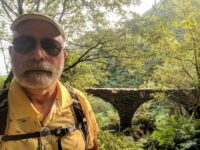
The End
By that point, I had hiked about five kilometers (three miles), more or less, and climbed perhaps 200 meters (about 650 feet) and done so without either coffee or breakfast.
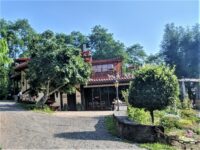 Memory plays tricks. Mine says I was beginning to negotiate with a higher power, perhaps offering a life of service, in exchange for a cup of coffee when I was saved by the appearance of the Twelve Tribes Pilgrims’ Hostel! They gave me coffee, toast, and jam and, when I committed a faux pas by asking for seconds, gave me them as well. But no bill, even when I asked to pay for my oh, so much appreciated, food and drink.
Memory plays tricks. Mine says I was beginning to negotiate with a higher power, perhaps offering a life of service, in exchange for a cup of coffee when I was saved by the appearance of the Twelve Tribes Pilgrims’ Hostel! They gave me coffee, toast, and jam and, when I committed a faux pas by asking for seconds, gave me them as well. But no bill, even when I asked to pay for my oh, so much appreciated, food and drink.
 From Twelve Tribes, it was but a short, and comfortable, walk before San Sebastian came into view with the spectacular beach, la playa Zurriola, in the foreground and the even more spectacular beach, la concha, just visible in the distance and on the right.
From Twelve Tribes, it was but a short, and comfortable, walk before San Sebastian came into view with the spectacular beach, la playa Zurriola, in the foreground and the even more spectacular beach, la concha, just visible in the distance and on the right.
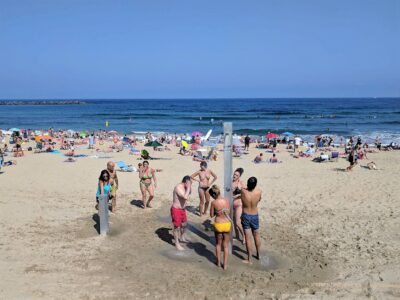 The short walk down the hill to the level road along the beach was more difficult than expected as it was steep and a steep downhill works the thighs very hard, indeed. But short it was. I made a brief foray along the beach, picked up my suitcase from the locker at the railroad station where I had stored it on August 3rd, explored a bit to be sure I knew how to find the Lacunza school, and arrived at the host family for my three week Spanish immersion course, Arantaxa and Carlos, without difficulty.
The short walk down the hill to the level road along the beach was more difficult than expected as it was steep and a steep downhill works the thighs very hard, indeed. But short it was. I made a brief foray along the beach, picked up my suitcase from the locker at the railroad station where I had stored it on August 3rd, explored a bit to be sure I knew how to find the Lacunza school, and arrived at the host family for my three week Spanish immersion course, Arantaxa and Carlos, without difficulty.
